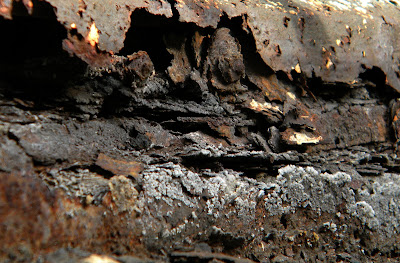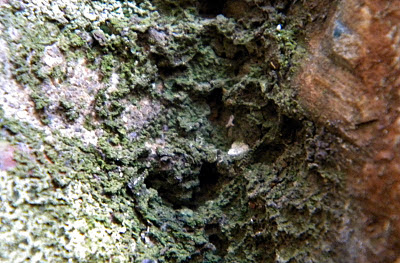Rust and Mold under the air-conditioner at a friends office. The rust is what's left of a window casing. The mold is among the nearby brick.
RUST: Circumstantial evidence convinces us that iron at one time, say thousands of years ago, might easily have been or in fact was distributed over portions of the earth in a metallic state and that the subsequent action of oxygen, sulphur, silica and other elements have converted it into the state in which it is now found and which is commonly called iron ore.
Iron ore resembles rust in appearance and not only contains the two important elements of rust, of which it principally consists, namely (Fe203), but it contains other elements as well, such as sulphur, and silica, &c.; hence it remains for man to undo what nature's laboratory has done for centuries and separate the elements closely united in the composition of the ore and thus obtain the metallic iron for use in the arts.
Rust is a reddish brown deposit, generally noticed on the surface of steel and iron after having undergone deterioration by chemical change, due to exposure to agencies, causing its formation. It ordinarily consists mostly of oxide of iron, together with other minor substances and water.
MOLDS: Molds (or moulds; see spelling differences) are fungi that grow in the form of multicellular filaments called hyphae.[1] Molds are not considered to be microbes but microscopic fungi that grow as single cells called yeasts. A connected network of these tubular branching hyphae has multiple, genetically identical nuclei and is considered a single organism, referred to as a colony.
I, (sookietex) the creator of this work, hereby release it into the public domain. This applies worldwide. In case this is not legally possible, I grant any entity the right to use this work for any purpose, without any conditions, unless such conditions are required by law.
If These images is subject to copyright in your jurisdiction, i (sookietex) the copyright holder have irrevocably released all rights to it, allowing it to be freely reproduced, distributed, transmitted, used, modified, built upon, or otherwise exploited in any way by anyone for any purpose, commercial or non-commercial, with or without attribution of the author, as if in the public domain.
TEXT CREDIT:
- Rust prevention Author: Lionel Moses Stern, Published: 1907, Original from: the University of California, Digitized: Oct 24, 2007, Length: 54 pages. Subjects: Corrosion and anti-corrosives.
- Mold From Wikipedia















No comments:
Post a Comment